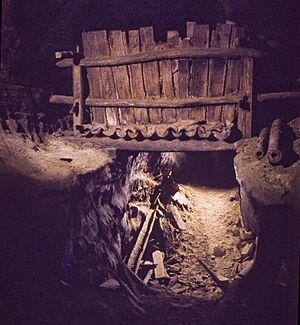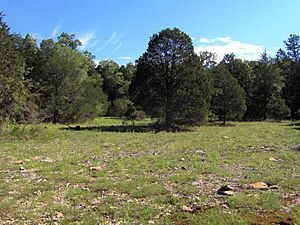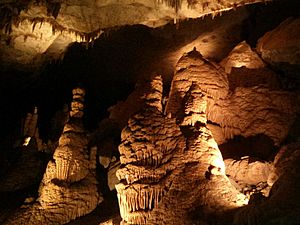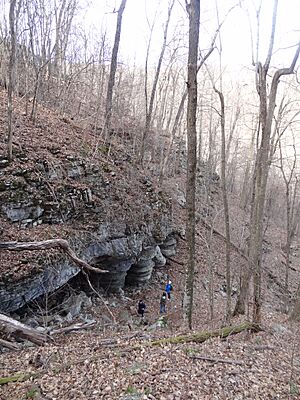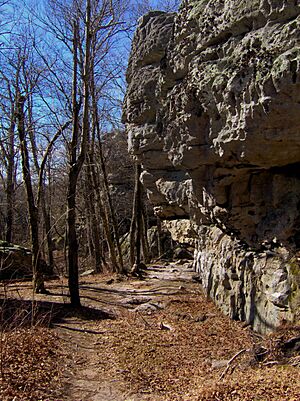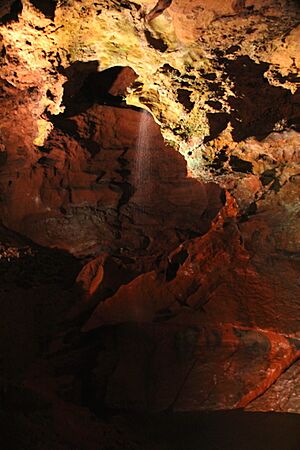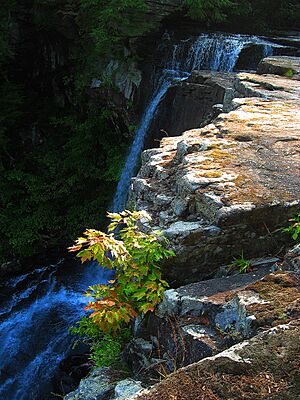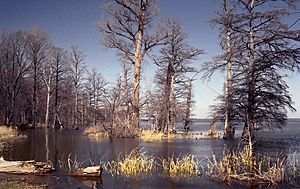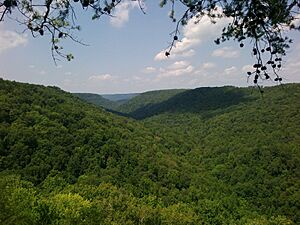List of National Natural Landmarks in Tennessee facts for kids
Tennessee is home to some amazing natural places, and 13 of them are so special that they've been named National Natural Landmarks! These landmarks are chosen because they show off the best examples of America's natural history. Think of them as living museums of nature, protecting important plants, animals, and geological features for everyone to enjoy and learn from.
Contents
Discovering Tennessee's Natural Wonders
Arnold Engineering Development Center Natural Areas
Designated in 1974, this area is located in Coffee County and is managed by the federal government at Arnold Air Force Base. It protects a very rare type of swamp forest that has never been cut down, along with a perfect example of an open marsh. It's like stepping back in time to see nature as it once was.
Big Bone Cave
This incredible cave in Van Buren County became a landmark in 1973. It's famous because scientists found bones of a giant ground sloth here! Imagine a sloth as big as a small car. The cave is managed by the state and offers a glimpse into ancient life.
Cedar Glades
Found in Wilson County and designated in 1973, the Cedar Glades are part of Cedars of Lebanon State Park. This area is the largest and best example of a "cedar glade" community. Cedar glades are unique rocky areas with thin soil where special plants grow, including some found nowhere else in the world.
Conley Hole
Also designated in 1973, Conley Hole is a privately owned landmark in Grundy County. It's considered one of the most amazing "pit caves" in the entire United States. Pit caves are vertical shafts that drop deep into the earth, often leading to larger cave systems below.
Cumberland Caverns
In Warren County, Cumberland Caverns became a landmark in 1973. This privately owned site is actually two caves connected together, stretching for at least 27 miles (about 43 kilometers)! It's a massive underground world with incredible formations.
Dick Cove
Designated in 1973, Dick Cove is a privately owned area in Franklin County. It's special because it contains a forest that is almost completely untouched by humans. This "near virgin forest" shows how woodlands looked before widespread logging.
Grassy Cove Karst Area
The Grassy Cove Karst Area in Cumberland County was designated in 1973. This privately owned landmark is one of the best places in the country to see "karst development." Karst is a type of landscape formed when water dissolves soluble rocks like limestone, creating sinkholes, caves, and underground rivers.
The Lost Sea
Designated in 1974, The Lost Sea is a privately owned cavern system in Monroe County. It's famous for having the largest known underground lake in the country! Imagine a huge lake hidden deep inside the earth.
May Prairie
In Coffee County, May Prairie became a landmark in 1974. This state-owned area is the largest and best example of a "relict prairie" left in Tennessee. A relict prairie is a grassland that remains from a time when prairies were more common in the region.
McAnulty's Woods
Designated in 1973, McAnulty's Woods is a privately owned landmark in Hardeman County. It's the only known example in western Tennessee of the "upland forests of the Mississippi Embayment." This means it's a rare forest type found on higher ground in the area where the Mississippi River once flowed into an ancient sea.
Piney Falls
Piney Falls in Rhea County was designated in 1974 and is part of the state's natural area system. It's home to a rare "virgin mixed mesophytic forest stand." This is a special type of forest that has never been logged and contains a mix of different tree species that thrive in moist, temperate climates.
Reelfoot Lake
Designated in 1966, Reelfoot Lake is a federal landmark in Lake and Obion counties, managed by the Reelfoot National Wildlife Refuge. This unique lake was formed by the powerful New Madrid earthquakes in the early 1800s. It's a mosaic of different habitats, making it a great place for wildlife.
Savage Gulf
Part of South Cumberland State Park, Savage Gulf in Grundy County was designated in 1971. This state-owned area protects a large "virgin forest," meaning it's an ancient woodland that has never been cut down or significantly disturbed by humans. It's a true natural treasure.


